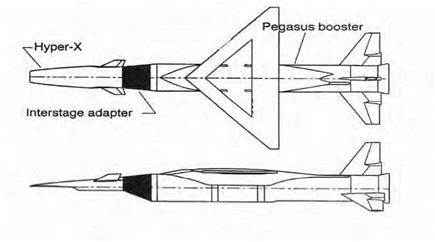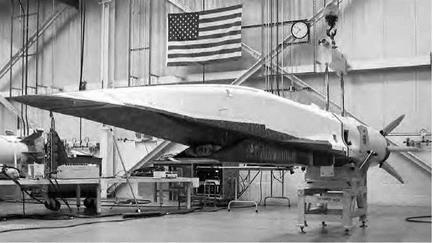Transatmospherics after NASP
Two developments have paced work in hypersonics since NASP died in 1995. Continuing advances in computers, aided markedly by advancements in wind tunnels, have brought forth computational fluid dynamics (CFD). Today, CFD simulates the aerodynamics of flight vehicles with increasing (though not perfect) fidelity. In addition, NASA and the Air Force have pursued a sequence of projects that now aim clearly at developing operational scramjet-powered military systems.
Early in the NASP effort, in 1984, Robert Whitehead of the Office of Naval Research spoke on CFD to its people. Robert Williams recalls that Williams presented the equations of fluid dynamics "so the computer could solve them, then showed that the computer technology was also there. We realized that we could compute our way to Mach 25 with high confidence.”[658] Unfortunately, in reality, DARPA could not do that. In 1987, the trade journal Aerospace America reported: "almost nothing is known about the effects of heat transfer, pressure gradient, three – dimensionality, chemical reactions, shock waves, and other influences on hypersonic transition.”[659] (This transition causes a flow to change from laminar to turbulent, a matter of fundamental importance.)
Code development did mature so that it could adequately support the next hypersonic system, NASA’s X-43A program. In supporting the X-43A effort, NASA’s most important code was GASP. NASP had used version 2.0; the X-43A used 3.0.[660] Like any flow code, it could not calculate the turbulence directly but had to model it. GASP 3.0 used the Baldwin-Lomax algebraic model that Princeton’s Antony Jameson, a leading writer of flow codes, describes as: "the most popular model in the industry, primarily because it’s easy to program.”[661] GASP 3.0 also uses "eddy-viscosity” models, which Stanford’s Peter Bradshaw rejects out of hand: "Eddy viscosity does not even deserve to be described as a ‘theory’ of turbulence!” More broadly, he adds, "Even the most sophisticated turbulence models are based on brutal simplifications” of the pertinent nonlinear partial differential equations.[662]
Can increasing computer power make up for this? Calculations of the NASP era had been rated in gigaflops, billions of floating point operations per second (FLOPS).[663] An IBM computer has recently cracked the petaflop mark—at a quadrillion operations per second, and even greater performance is being contemplated.[664] At Stanford University’s Center for Turbulence Research, analyst Krishnan Mahesh studied flow within a commercial turbojet and found a mean pressure drop that differs from the observed value by only 2 percent. An earlier computation had given an error of 26 percent, an order of magnitude higher.[665] He used Large Eddy Simulation, which calculates the larger turbulent eddies and models the small ones that have a more universal character. But John Anderson, a historian of fluid dynamics, notes that LES
"is not viewed as an industry standard.” He sees no prospect other than direct numerical simulation (DNS), which directly calculates all scales of turbulence. "It’s clear-cut,” he adds. "The best way to calculate turbulence is to use DNS. Put in a fine enough grid and calculate the entire flow field, including the turbulence. You don’t need any kind of model and the turbulence comes out in the wash as part of the solution.” But in seeking to apply DNS, even petaflops aren’t enough. Use of DNS for practical problems in industry is "many decades down the road. Nobody to my knowledge has used DNS to deal with flow through a scramjet. That type of application is decades away.”[666] With the limitations as well as benefits of CFD more readily apparent, it thus is significant that more traditional hypersonic test facilities are also improving. As just one example, NASA Langley’s largest hypersonic facility, the 8-foot High Temperature Tunnel (HTT), has been refitted to burn methane and use its combustion products, with oxygen replenishment, as the test gas. This heats the gas. As reviewed by the Journal of Spacecraft and Rockets: "the oxygen content of the freestream gas is representative of flight conditions as is the Mach number, total enthalpy, dynamic pressure, and Reynolds number.”[667]
One fruitful area with NASP had been its aggressive research on scramjets, which benefited substantially because of NASA’s increasing investment in high-temperature hypersonic test facilities.[668]
Table 3 enumerates the range of hypersonic test facilities for scramjet and aerothermodynamic research available to researchers at the NASA Langley Research Center. Between 1987 and the end of 1994, Langley researchers ran over 1,500 tests on 10 NASP engine modules, over 1,200 in a single 3-year period, from the end of 1987 to 1990. After NASP wound down, Agency researchers ran nearly 700 tests on four other configurations between 1994 and 1996. These tests, ranging from Mach 4 to Mach
|
TABLE 3 |
|||
|
NASA LRC SCRAMJET PROPULSION AND AEROTHERMODYNAMIC TEST FACILITIES |
|||
|
FACILITY NAME |
MACH |
REYNOLDS NUMBER |
SIZE |
|
8-foot High Temperature Tunnel |
4, 5, 7 |
0.3-5.1 x 106 / ft. |
8-ft. dia. |
|
Arc-Heated Scramjet Test Facility |
4.7-8.0 |
0.04-2.2 x 106 / ft. |
4-ft. dia. |
|
Combustion-Heated Scramjet Test Facility |
3.5-6.0 |
1.0-6.8 x 106 / ft. |
42" x 30" |
|
Direct Connect Supersonic Combustion Test Facility |
4.0-7.5 |
1.8-31.0 x 106 / ft. |
[Note (a)] |
|
HYPULSE Shock Tunnel [Note (b)] |
5.0-25 |
0.5-2.5 x 106 / ft. |
7-ft dia. |
|
15-inch Mach 6 High Temperature Tunnel |
6 |
0.5-8.0 x 106 / ft. |
15" dia. |
|
20-inch Mach 6 CF4 Tunnel |
6 |
0.05-0.7 x 106 / ft. |
20" dia. |
|
20-inch Mach 6 Tunnel |
6 |
0.5-8.0 x 106 / ft. |
20" x 20" |
|
31 – inch Mach 10 Tunnel |
10 |
0.2-2.2 x 106 / ft. |
31" x 31" |
|
Source: Data from NASA LRC Facility brochures. (a) DCSCTF section varies: 1.52" x 3.46" with a M = 2 nozzle and 1.50" x 6.69" with a M = 2.7 nozzle. (b) LRCs HYPULSE shock tunnel is at the GASL Division of Allied Aerospace Industries, Ronkonkoma, NY. |
8, so encouraged scramjet proponents that they went ahead with plans for a much-scaled-back effort, the Hyper-X (later designated X-43A), which compared in some respects with the ASSET program undertaken after cancellation of the X-20 Dyna-Soar three decades earlier.[669]
The X-43, managed at Langley Research Center by Vincent Rausch, a veteran of the earlier TAV and NASP efforts, began in 1995 as Hyper-X, coincident with the winddown of NASP. It combined a GASL scramjet engine with a 100-inch-long by 60-inch-span slender lifting body and an Orbital Sciences Pegasus booster, this combination being carried to a launch altitude of 40,000 feet by NASA Dryden’s NB-52B Stratofortress. After launch, the Pegasus took the X-43 to approximately 100,000 feet,
|
Schematic layout of the Hyper-X (subsequently X-43A) scramjet test vehicle and its Orbital Sciences Pegasus winged booster, itself a hypersonic vehicle. NASA. |
where it would separate, demonstrating scramjet ignition (using silane and then adding gaseous hydrogen) and operation at velocities as high as Mach 10.
The X-43 program cost $230 million and consumed not quite a decade of development time. Built by Microcraft, Inc., of Tullahoma, TN, the X-43 used the shape of a Boeing study for a Mach 10 global reconnaissance and space access vehicle, conceived by a team under the leadership of George Orton. Langley Research Center furnished vital support, executing nearly 900 test runs of 4 engine configurations between 1996 and 2003.[670]
Microcraft completed three X-43A flight-test vehicles for testing by NASA Dryden Flight Research Center. Unfortunately, the first flight attempt failed in 2001, when the Pegasus booster shed a control fin after launch. A 3-year reexamination and review of the program led to a successful flight on March 27, 2004, the first successful hypersonic flight of a scramjet-powered airplane. The Pegasus boosted the X-43A to Mach 6.8. After separation, the X-43A burned silane, which ignites on contact
with the air, for 3 seconds. Then it ramped down the silane and began injecting gaseous hydrogen, burning this gas for 8 seconds. This was the world’s first flight test of such a scramjet.[671]
That November, NASA did it again with its third X-43A. On November 16, it separated from its booster at 110,000 feet and Mach 9.7 and its engine burned for 10 to 12 seconds with silane off. On its face, this looked like the fastest air-breathing flight in history, but this speed (approximately 6,500 mph) resulted from its use of Pegasus, a rocket. The key point was that the scramjet worked, however briefly. During the flight, the X-43A experienced airframe temperatures as high as 3,600 °F.[672]
Meanwhile, the Air Force was preparing to take the next step with its HyTech program. Within it, Pratt & Whitney, now merged with Rocketdyne, has been a major participant. In January 2001, it demonstrated the Performance Test Engine (PTE), an airframe-integrated scramjet that operated at hypersonic speeds using the hydrocarbon JP-7. Like the X-43A engine, though, the PTE was heavy. Its successor, the Ground Demonstrator Engine (GDE), was flight-weight. It also used fuel to cool the engine structure. One GDE went to Langley for testing in the HTT in 2005. It made the important demonstration that the cooling could be achieved using no more fuel than was to be employed for propulsion.
Next on transatmospheric agenda is a new X-test vehicle, the X-51A, built by Boeing, with a scramjet by Pratt & Whitney Rocketdyne. These firms are also participants in a consortium that includes support from NASA, DARPA, and the Air Force. The X-51A scramjet is fuel-cooled, with the cooling allowing it to be built of Inconel 625 nickel alloy rather than an exotic superalloy. Lofted to Mach 4.7 by a modified Army Tactical Missile System (ATACMS) artillery rocket booster, the X-51A is intended to fly at Mach 7 for minutes at a time, burning JP-7, a hydrocarbon fuel
|
The first Boeing X-51 WaveRider undergoing final preparations for flight, Edwards AFB, California, 2010. USAF |
used previously on the Lockheed SR-71. The X-51A uses ethylene to start the combustion. Then the flight continues on JP-7. Following checkout trials beginning in late 2009, the X-51 made its first powered flight on May 26, 2010. After being air-launched from a B-52, it demonstrated successful hydrocarbon scramjet ignition and acceleration. Further tests will hopefully advance the era of practical scramjet-powered flight, likely beginning with long-range missiles. As this review indicates, the story of transatmospherics illustrates the complexity of hypersonics; the tenacity and dedication of NASA’s aerodynamics, structures, and propulsion community; and the Agency’s commitment to take on challenges, no matter how difficult, if the end promises to be the advancement of flight and humanity’s ability to utilize the air and space medium.[673]












